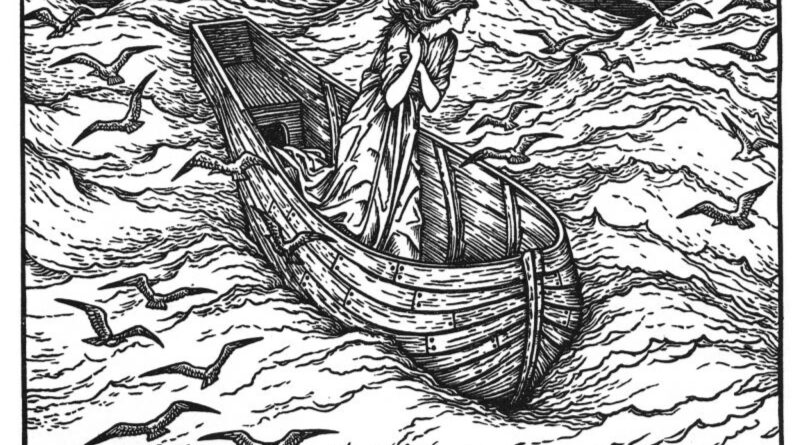Three free archives of Victorian illustration to inspire you
It’s fascinating to compare how illustrators have depicted great works of literature through the ages. For example, Arthur Rackham’s plates to accompany The Goblin Market by Christina Rosetti are celebrated examples of work from the Golden Age of Illustration. Yet, it’s just as intriguing to see how contemporary illustrators such as Georgie McAusland or Laura Laine have interpreted the poem.
If classic literature brought to life in works of art inspires you, then it’s worth pointing your web browser towards three new archives of Victorian imagery released online by Michael John Goodman. They include the Victorian Illustrated Shakespeare Archive, the Charles Dickens Illustrated Gallery and the Kelmscott Chaucer Online.
Victorian Illustrated Shakespeare Archive
This collection of over 3000 images covers dozens of plays, poems, songs and sonnets by arguably England’s greatest writer. It includes some of the first colour illustrations of Shakespeare’s works ever printed – found in the John Murdoch Edition of A Midsummer Night’s Dream. “I find this edition absolutely fascinating,” says Michael John Goodman. “The illustrations look very distinctive, printed in chromolithography. Mysteriously, there are no details of who the illustrator was, which just adds to the enigmatic nature of the edition.”
The Welsh illustrator Kenny Meadows, who also worked for Punch magazine, is to be found in the archive depicting the Scottish play. You will also enjoy John Gilbert’s imagery to accompany King Lear, and there are some fascinating engravings by John Tallis & Co. – including detailed renderings of Ellen and Kate Bateman, who starred as Richard III and Richmond on stage in the 1840s.

Ellen and Kate Bateman as Richard III and Richmond – John Tallis Edition

A Midsummer Night’s Dream – John Murdoch Edition

King Lear and the Fool – John Gilbert
The Kelmscott Chaucer Online
Designers and illustrators around the world continue to feel the influence of William Morris, a leader of the Arts & Crafts movement in the late 19th century. The Kelmscott Chaucer is a book designed by Morris with 87 woodcut illustrations by the Pre-Raphaelite artist Edward Burne-Johns.
As expected, there are illustrations for The Canterbury Tales, such as The Wife of Bath and The Knight. But there’s so much more – like an exquisite rendering of Chaucer himself with a book in one hand and quill in the other. “He is lost in thought while birds in the tree look gently down at him as mountains recede into the background. It is an authoritative opening artistic statement by Burne-Jones, who is presenting to us here book illustration as we’ve never seen it before,” says Michael.
William Morris’s illuminated script and borders, created for this edition, represent some of the finest examples of Arts and Crafts organic patterning anywhere to be found. Without works like these, Laura Ashley would never have existed.

Prologue – Edward Burne-Jones and William Morris

A Treatise on the Astrolabe – Edward Burne-Jones

The House of Fame – Edward Burne-Jones
The Charles Dickens Illustrated Gallery
Like the Shakespeare Archive, the Charles Dickens Illustrated Gallery contains a wide variety of illustrations of varying styles and quality. Browsing them, you may get the feeling that some of the artworks were completed quickly – this was the popular fiction of the day, and elements of caricature and comic drawing similar to that of Victorian magazines can be seen. However, while this is not fine art, by and large, the illustrations are highly rendered, and the visual storytelling is often strong and compelling.
See, for example, Nicholas Nickleby, Bleak House and Oliver Twist – could Bill Sikes on the rooftop have inspired Dr Seuss’s Grinch? Perhaps the most famous piece, says Michael, is John Leech’s 1843 frontispiece to A Christmas Carol, depicting Mr Fezziwig’s Ball. “It is the only one of Dickens’s books to feature coloured illustrations. Despite selling out in days and being extraordinarily popular, the cost of producing A Christmas Carol left Dickens with very little profit, perhaps explaining why subsequent Christmas books did not feature coloured images again,” he says.

Mr Fezziwig’s Ball – A Christmas Carol

Nicholas Engaged as a Tutor in a Private Family – Nicholas Nickleby

The Last Chance – Oliver Twist
Process and purpose
These three digital archives have come about mainly through Michael John Goodman’s passion for the projects, which he has financed himself. After researching each area of literature, he sought surviving books on eBay and AbeBooks, hoping the illustrations inside remained intact and that the reproductions were of sufficient quality. The images were flatbed scanned, with foxing and staining cleaned up in Photoshop.
As the imagery is out of copyright, creatives are free to download, browse, share, remix, research or use it as they wish. At times, no doubt, they will be reproduced without credit to the original artist or reference to the intent of the work. However, we can see them being very useful for inspiration or as vintage elements within contemporary montages. They may prove useful in mood boards and pitch decks, helping define the creative direction and aesthetic of brands or campaigns.
“I hope creatives just feel confident and empowered to use the collections in their projects,” says Michael. “Whether that is through education and learning that graphic design has a history that extends all the way back to the 19th century, or if they are looking for inspiration and source material, I encourage everyone to play around and experiment with the images. I’m always fascinated to hear how people are using the collections in their work, and I’m thrilled when people get in contact with me.”

